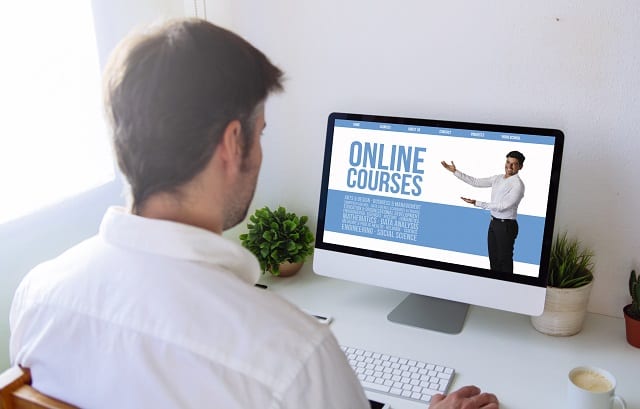
Introduction
The global pandemic was a watershed moment for eLearning. Companies and organisations that had previously not adopted or who had only dabbled in eLearning were thrust into an environment that necessitated the shift to online learning for their employees. In effect, it was either adapt and go online or provide no training and development to your employees.
One group in particular found that although the experience was initially painful, the results were somewhat unexpected. What group you ask? Schools… Primary, Secondary and Tertiary schools had to rapidly implement online learning for their cohorts. Teachers were forced to rapidly learn how to create online curriculum and build content and lesson plans. There was literally no other alternative. And in a lot of cases, students actually preferred the new world to the old one! One study into the effectiveness of online learning during the pandemic showed that 80% of students wanted online learning in some form to continue post return to campus (BMC Medical 2021).
This result is not limited to schools and Universities. Employers found that many of their employees welcomed the opportunity to engage in online learning for career development or to maintain necessary licensing or certification.
The experiences of learners during the pandemic were not uniformly positive. For every positive study, there are other studies that show learners had a negative experience. Why the mixed results? Simple. It boils down to how the online learning is structured and delivered. In this article, we’re going to lay out some critical success factors that will help to ensure your eLearning is effective and engages your learners.
How Do You Ensure eLearning Is Effective?
So, let’s start by looking at what you can do to ensure that your eLearning courses are as effective and engaging as possible. Doing this will maximize your learner satisfaction. Curious? Let’s take a look:
- Offer learning objectives: telling your students what they are about to learn and why it is important will significantly increase the likelihood of engagement. Tell the learner what they are about to learn, why it’s important, how the course is made up and how long it will take to complete. Time is precious. To get a learner to commit to your course, let them know what they are in for.
- Structure: if your eLearning course is badly structured, you will confuse the learner. You need to break the content into clear, logical sections that each individual can easily follow. Take some time to think about what it is you actually want the learner to walk away with. A good rule of thumb is the rule of three. No more than three topics or key themes per course. Make sure the navigation through the course is easy to follow. Consider building an orientation to the actual learning system itself. Help your learner gain confidence that they know how to drive the technology and understand how to get the most out of the learning experience.
- Visuals: you don’t want to be that person that produces a course that is all text. You may be enamoured with reading great wads of text, but your learner probably isn’t. The old saying that a picture is worth a thousand words holds true for eLearning. An experienced course designer that knows how to convert 10 pages of text into one interactive diagram is worth their weight in gold.
- Interaction: Make sure you build some activities into your course. There is an ever increasing range of creative tools at your disposal that allows you to implement some interesting learning experiences into your course. Activities allows you to introduce the learn, try, apply concept. Provide the learner with some information, quiz them on what you have just told them and then get them involved in a scenario to see how well they are able to apply the new knowledge. Here’s a few ideas:
- Quizzes – 30 Best eLearning Examples That Are a Must-See in 2022 (ispringsolutions.com)
- Interactive scenarios – New Product Testing (smartbuilder.com)
- Interactive simulations – Nature Of Light (smartbuilder.com)
- Animated story – Why do we need HTTPS? – How HTTPS works
- Live polling – Polls, Surveys & Quizzes for School & University – Mentimeter
- Stay on topic: just because the person is learning online does not mean that they have endless time and patience. You need to make sure your course content is focused and related to a specific purpose. Don’t ramble. Cut anything unnecessary. Concise content is far more engaging for the user and provides an efficient learning experience.
- Positivity: make sure that your course is enjoyable by making it upbeat. Your written and audio content should have engaging and positive audio, presenters, messages. Nothing wrong with injecting some humour into your course. Learning doesn’t have to be serious! Make sure the voice over is not a flat, monotone level.
- Visuals: I can’t tell you how many times I have seen a good course ruined by poor visuals. White text on top of a yellow box is virtually impossible to read. Check that your use of color is both visually appealing and user friendly. 8% of your audience is color blind, some of your audience may be visually impaired. Consider resources such as G14: Ensuring that information conveyed by color differences is also available in text (w3.org). In short, if your course does not look visually appealing it will distract or disengage many of your learners.
- Mobile friendly: You should always check to see if the learners will be accessing the course via a mobile device before you start building. If a large percentage of your learners intend or will access your course via mobile, then you will need to tailor your build to ensure that it works on a mobile format.
Of course, there are many other things that individual course developers can do to improve their courses, but these are the top things you should consider when looking at building an eLearning course. Have I missed something? Feel free to add your opinion.

What does Optivly Do?
At Optivly, we place a huge importance on getting the look and feel right. Sometimes, we have to challenge our clients when they want to impose their Marketing Brand Guidelines onto an eLearning course (for example). We are happy to include colors from a company’s corporate livery but sometimes we have to remind our clients that we are not building a marketing piece. We are building a learning experience. Not to pick on you marketing people, we love you guys! It’s just that we are not marketing to people, so our course does not need to be in your corporate brand style guide constraints (except for the use of your logo).
In order to get our look and feel right, we must ensure that we cater for the learners needs. Colors and visuals must take in to account that some learners may have visual impairment or be color blind. We need to ensure that text is able to be read clearly and is not juxtaposed on a background that makes the content hard to read because we know that if it’s hard to read, the learner is less likely to read it and more likely to start to disengage with the course.
What Aspects Of eLearning Could Be Improved?
One of the biggest weaknesses of online learning is that students do not have other classmates or face-to-face contact with their teacher, and this can impact engagement levels. In order to combat this, consider setting up group sessions, encouraging classmates to work together, and providing some face-to-face options or voice options. We often setup discussion groups that are either synchronous or asynchronous which allows people to chat to each other, test theories and get feedback from the group and from the facilitator.
Working with their peers can make a massive difference in how engaged your learners are as it helps to address another challenge with online learning – distance and isolation. Even the most introverted of people needs the occasional interaction with a fellow human being! Online learning can be a little isolating which can lead to motivation and attention issues. Summing up the willpower or discipline to commence online learning can be a challenge for many learners so having a scheduled group video call to discuss a topic or complete an activity helps to bridge the isolation and motivate people to stay involved and engaged.
Another thing that is often lacking in eLearning courses is mobile accessibility. Many people who undertake eLearning courses want to learn on the go – and this is something you should aim to offer if you possibly can. Many eLearning courses are not designed to be mobile friendly and offer a poor user experience if they work at all. Some authoring tools allow you to visualise what your course looks like in different formats before you publish it. This is a great discipline to get in to and your learners will appreciate it.
What Does A Great eLearning Experience Look Like?
One of the first things that a great eLearning experience should do is take into account the student’s knowledge when they start and, to some degree, tailor the content to their needs. This may not always be possible, but the more students feel like the content is specific to them, the better the experience will be. In other words, don’t treat all learners the same.
A great approach (depending on the topic) is to actually test the learner up front. See what they already know and then only direct them to the content areas where their knowledge was lacking. This is especially important for adult learners. As adults, we want to feel like we have some control over our learning journey and we want our existing experience and knowledge acknowledged.
A great eLearning experience often encourages the student to learn more, offering links or recommendations to further resources they can follow up on. This should be done throughout the course, not just at the end. Encourage the learner to explore deeper in to a topic if they have a desire to.
Depending on the complexity of the subject matter or the length of the course, a great learning experience is to create a virtual campus type feel for the learner. When the learner lands in your course, they go through an ‘orientation’ just like you did when you went to University. Introduce the facilitators and establish their credibility, provide information on all of the support available including course support and technical support. Give your learner training and familiarisation with how to navigate their course and what the assessments will be. Create an area where facilitators can post additional learning resources. For example, if a facilitator found a great youtube video talking about the topic at hand, let them post that and share with the learners. This helps the learners feel like the course is alive, dynamic and current.

Conclusion
Understanding what makes a great eLearning course good is important if you want to engage your learners and make them want to complete your course.
One of the great indicators of how well a course has been designed is the amount (or lack thereof) of support calls from the learner and the lack of calls and emails from the facilitator to the learner trying to motivate them to complete the course or finish the assessment.
A well designed eLearning course will have great completion rates, satisfied learners and if there is an assessment, a high pass rate. In short, the success will speak for itself.
References
https://www.elucidat.com/elearning-best-practice/
https://elearningindustry.com/7-tips-to-develop-successful-interactive-elearning-strategy
https://elearningindustry.com/successful-elearning-course-characteristics
https://elearningindustry.com/increase-elearning-engagement-9-simple-steps
